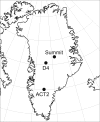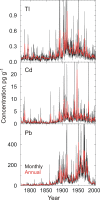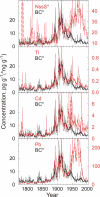Coal burning leaves toxic heavy metal legacy in the Arctic
- PMID: 18711138
- PMCID: PMC2529165
- DOI: 10.1073/pnas.0803564105
Coal burning leaves toxic heavy metal legacy in the Arctic
Abstract
Toxic heavy metals emitted by industrial activities in the midlatitudes are transported through the atmosphere and deposited in the polar regions; bioconcentration and biomagnification in the food chain mean that even low levels of atmospheric deposition may threaten human health and Arctic ecosystems. Little is known about sources and long-term trends of most heavy metals before approximately 1980, when modern measurements began, although heavy-metal pollution in the Arctic was widespread during recent decades. Lacking detailed, long-term measurements until now, ecologists, health researchers, and policy makers generally have assumed that contamination was highest during the 1960s and 1970s peak of industrial activity in North America and Europe. We present continuous 1772-2003 monthly and annually averaged deposition records for highly toxic thallium, cadmium, and lead from a Greenland ice core showing that atmospheric deposition was much higher than expected in the early 20th century, with tenfold increases from preindustrial levels by the early 1900s that were two to five times higher than during recent decades. Tracer measurements indicate that coal burning in North America and Europe was the likely source of these metals in the Arctic after 1860. Although these results show that heavy-metal pollution in the North Atlantic sector of the Arctic is substantially lower today than a century ago, contamination of other sectors may be increasing because of the rapid coal-driven growth of Asian economies.
Conflict of interest statement
The authors declare no conflict of interest.
Figures






References
-
- MacDonald RW, et al. Contaminants in the Canadian Arctic: 5 years of progress in understanding sources, occurrence, and pathways. Sci Total Environ. 2000;254:93–234. - PubMed
-
- Van Oostdam J, et al. Human health implications of environmental contaminants in Arctic Canada: a review. Sci Total Environ. 1999;230:1–82. - PubMed
-
- Dietz R, et al. Comparison of contaminants from different trophic levels and ecosystems. Sci Total Environ. 2000;245:221–231. - PubMed
-
- Dietz R, Riget F, Born EW. Geographical differences of zinc, cadmium, mercury, and selenium in polar bears (Ursus maritimus) from Greenland. Sci Total Environ. 2000;245:25–47. - PubMed
-
- Cheam V. Thallium contamination of water in Canada. Water Qual Res J Can. 2001;36:851–877.
Publication types
MeSH terms
Substances
LinkOut - more resources
Full Text Sources

